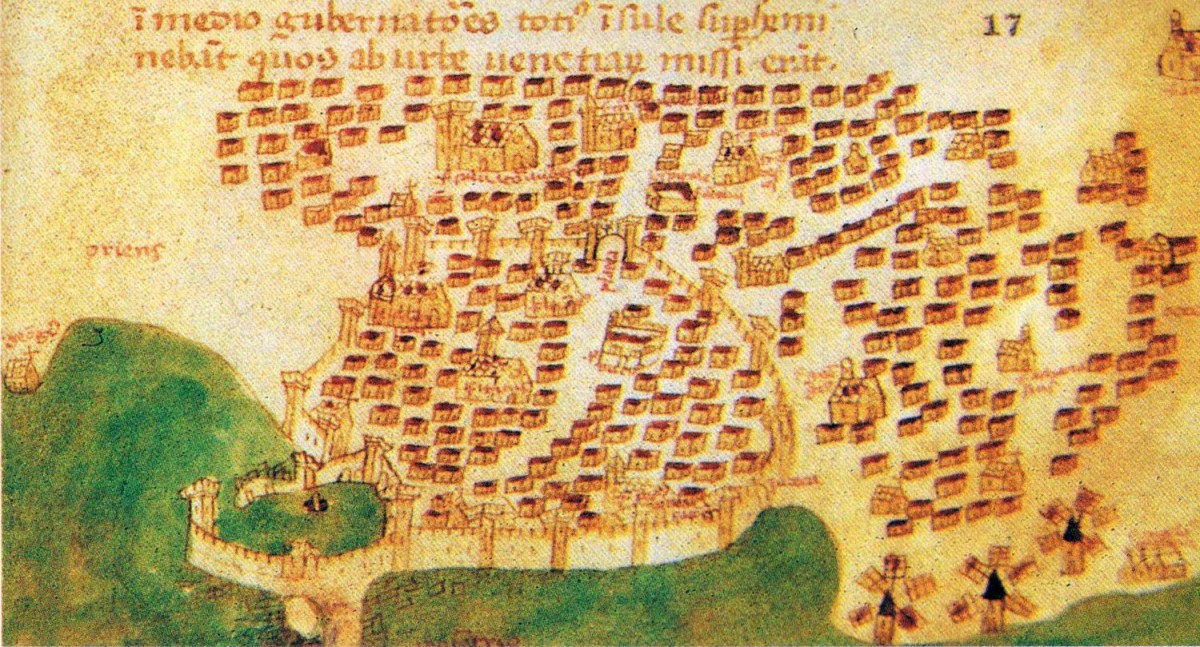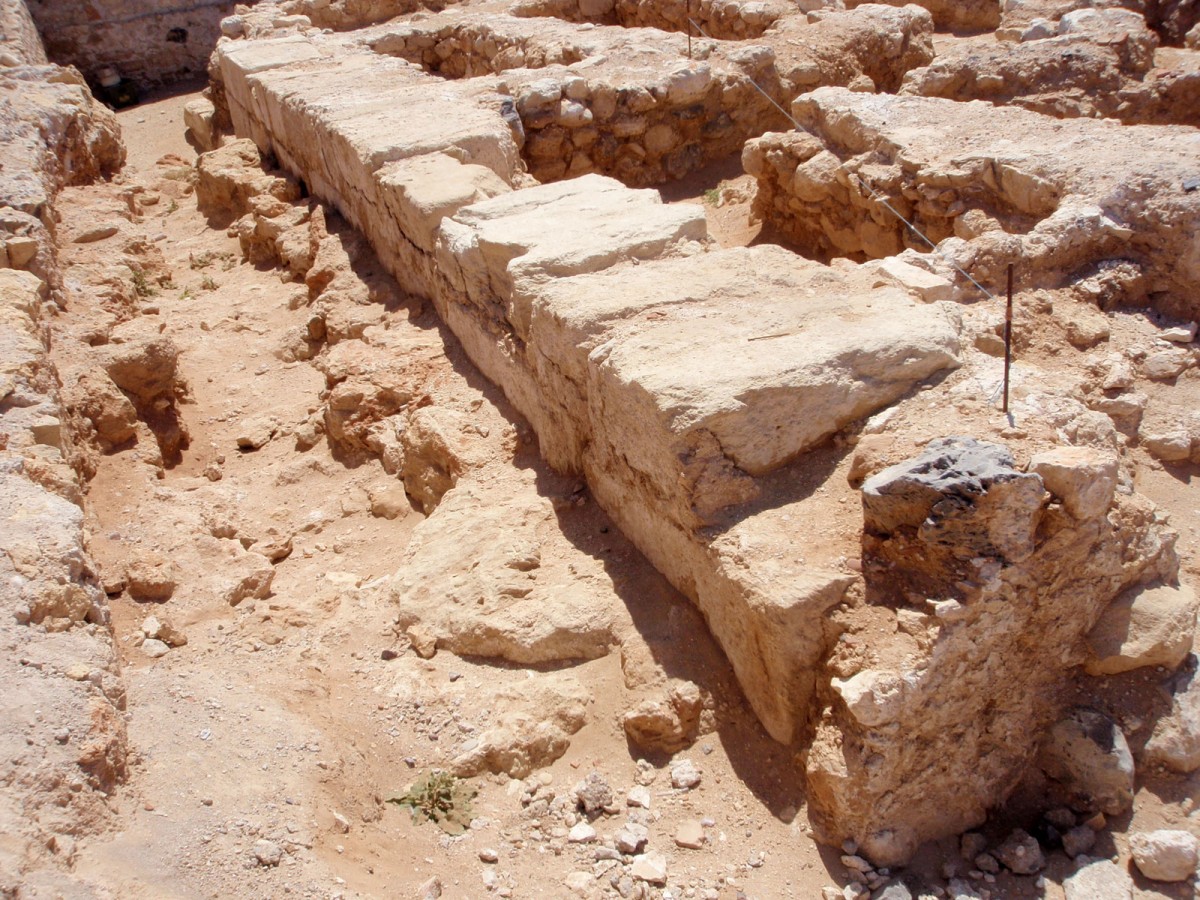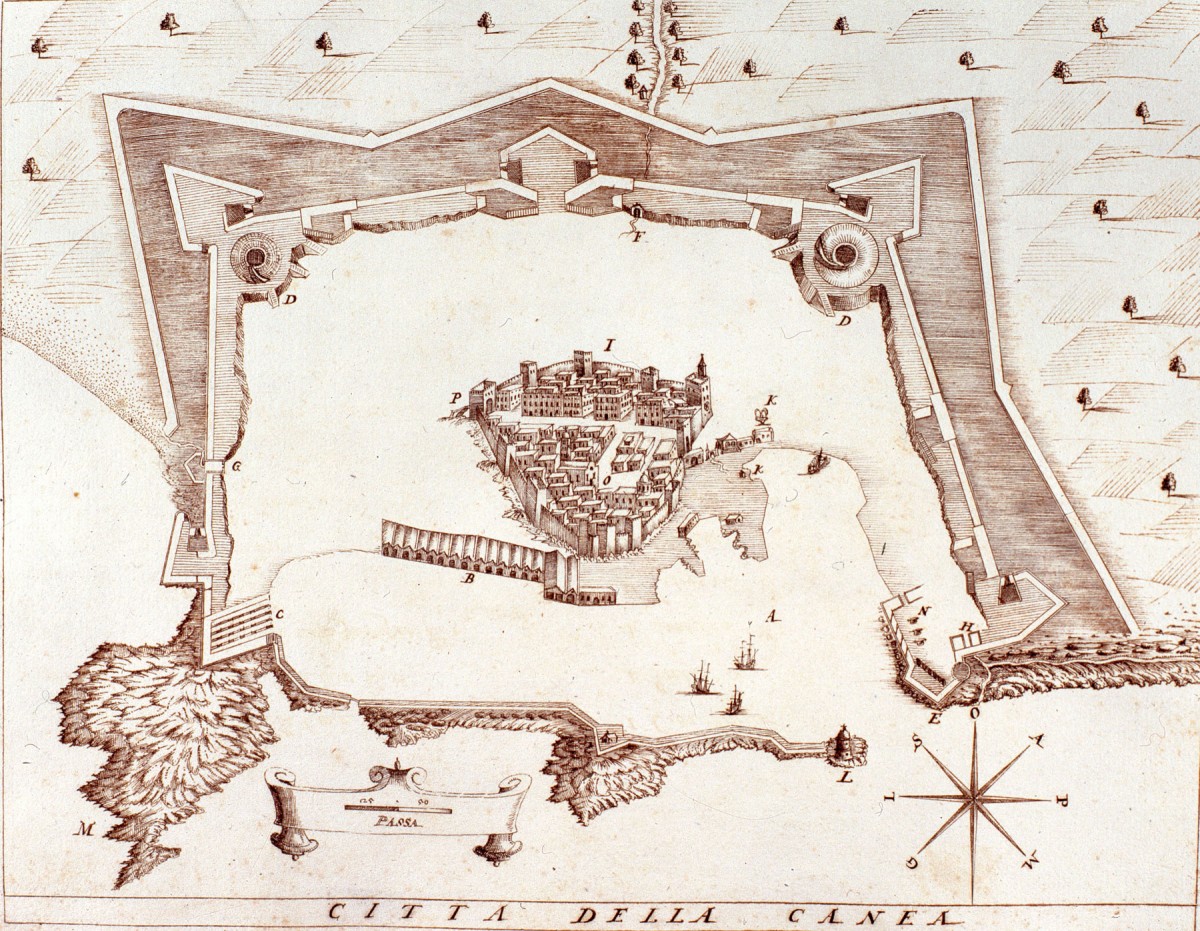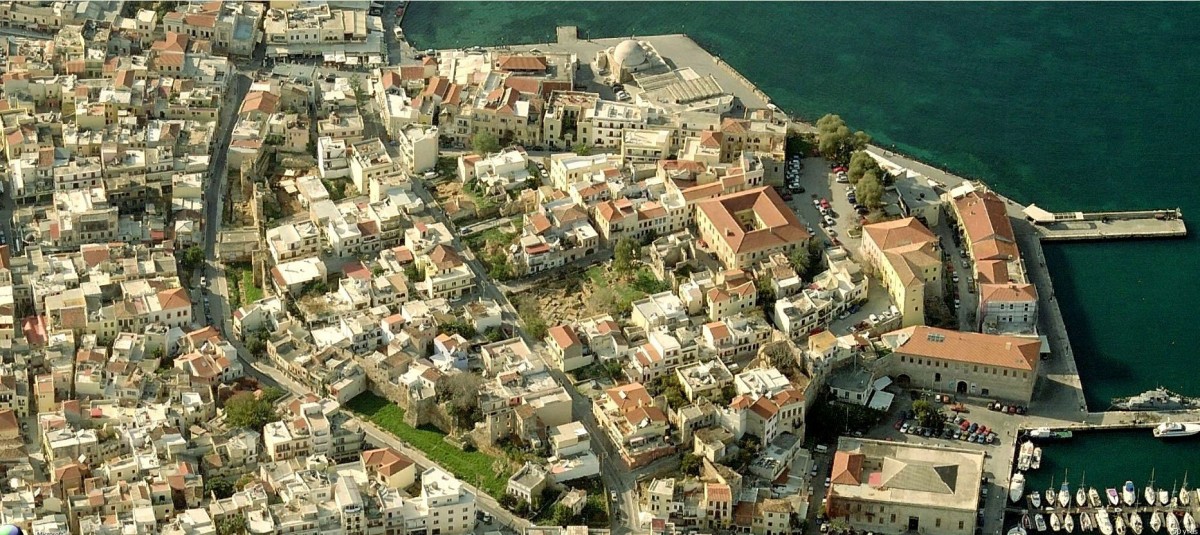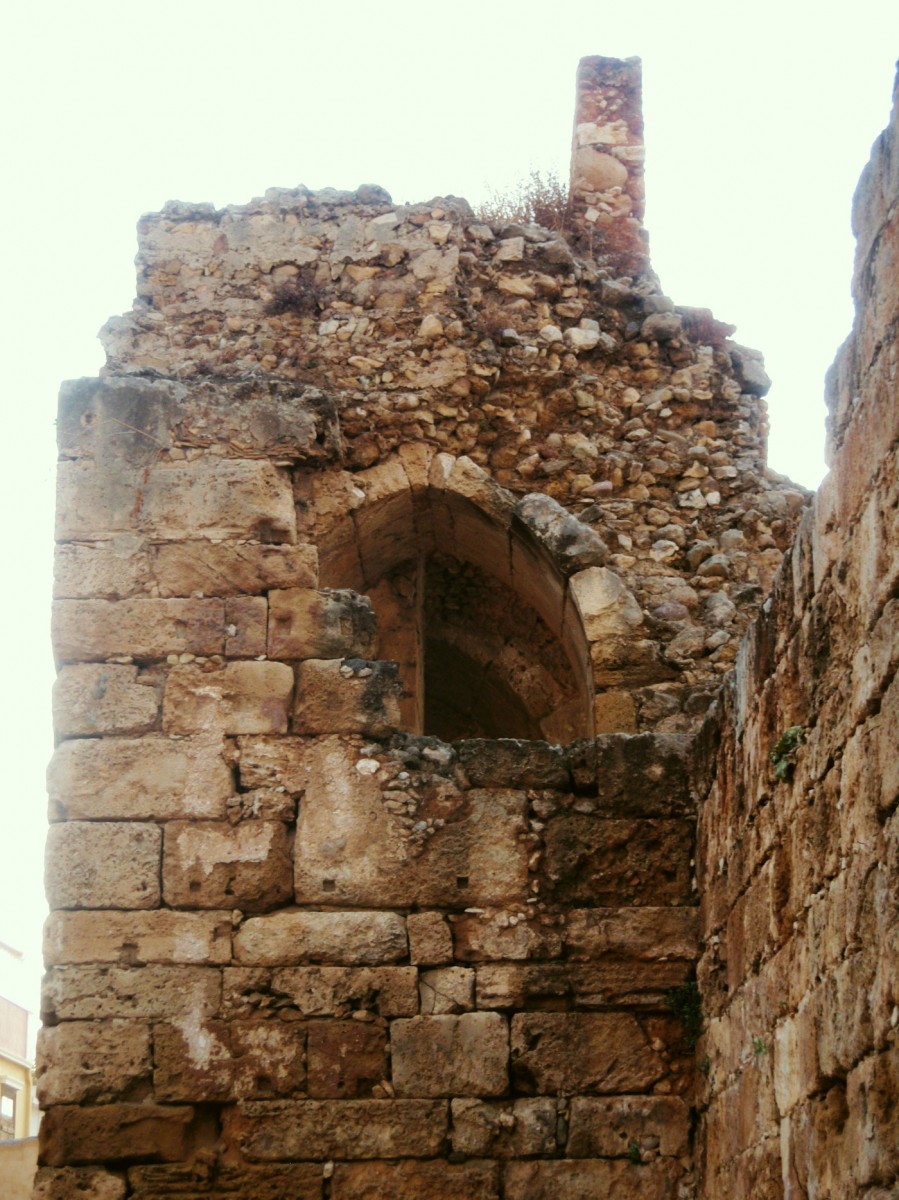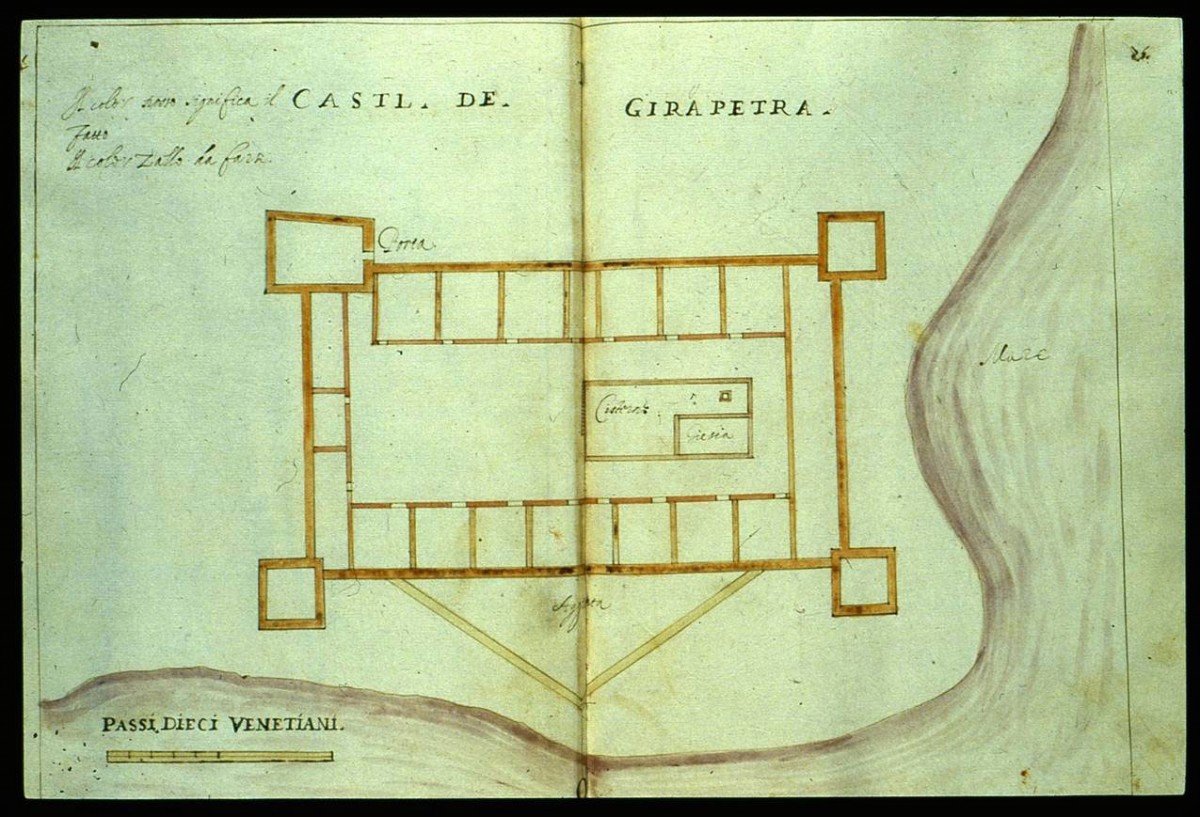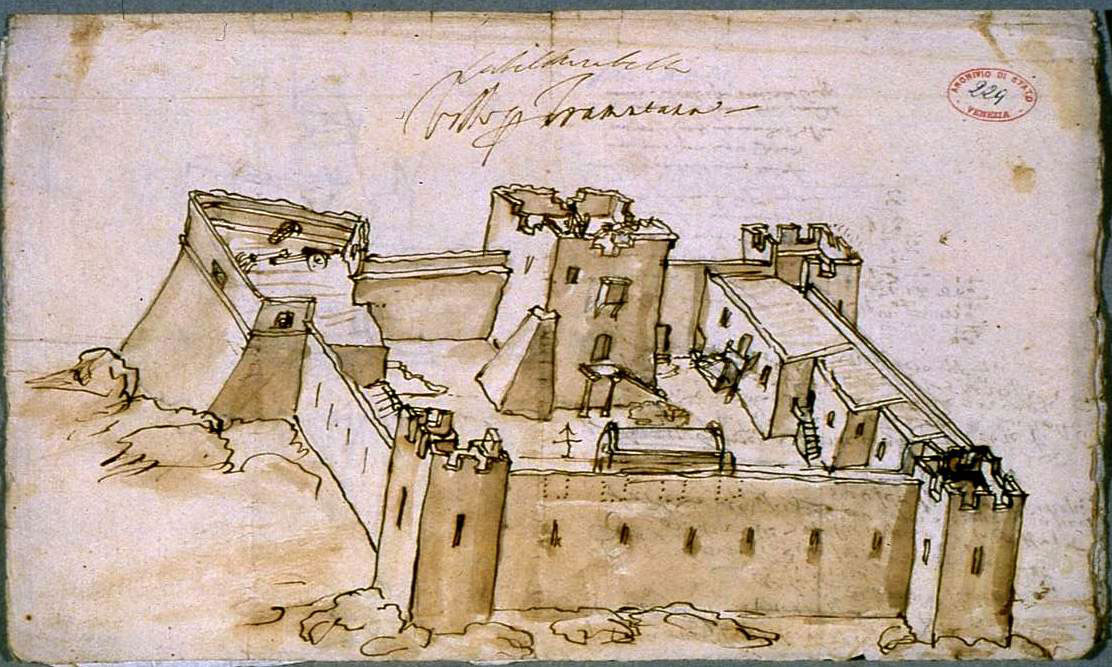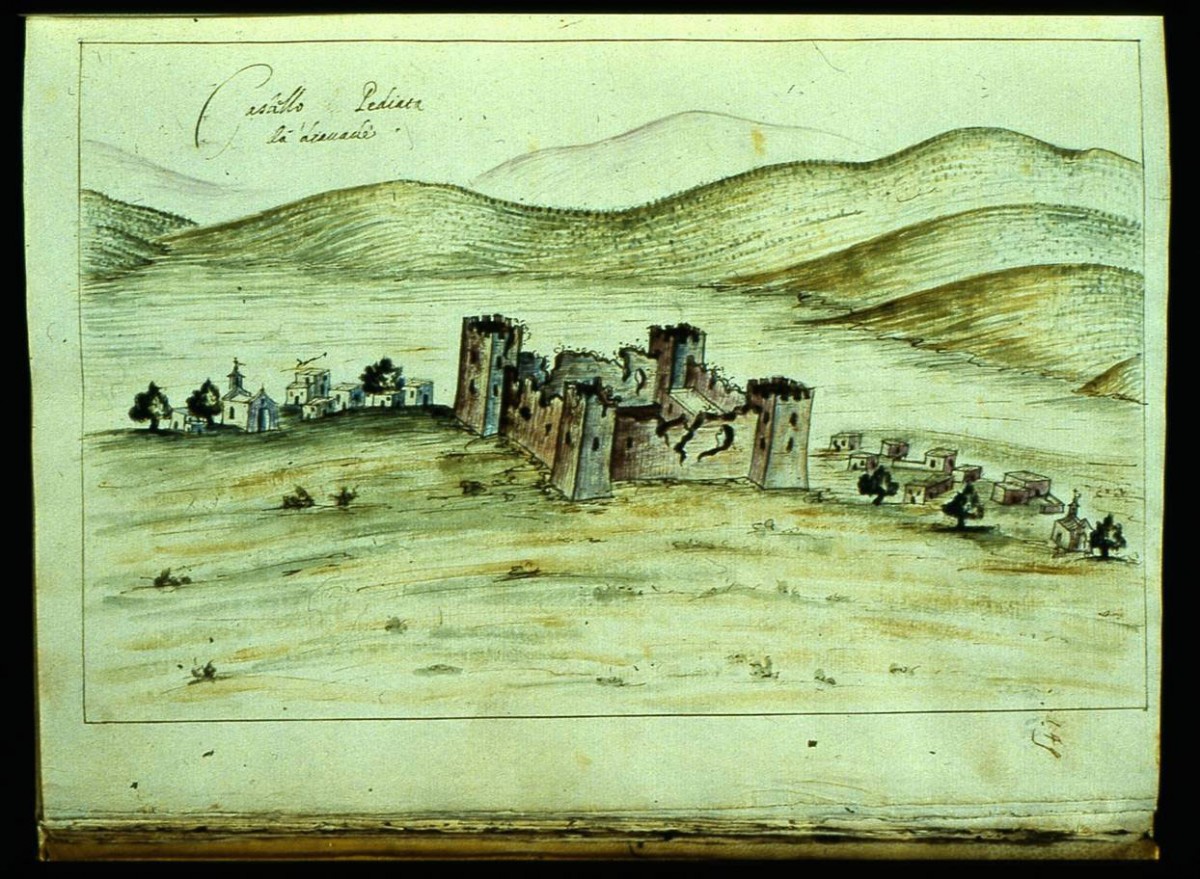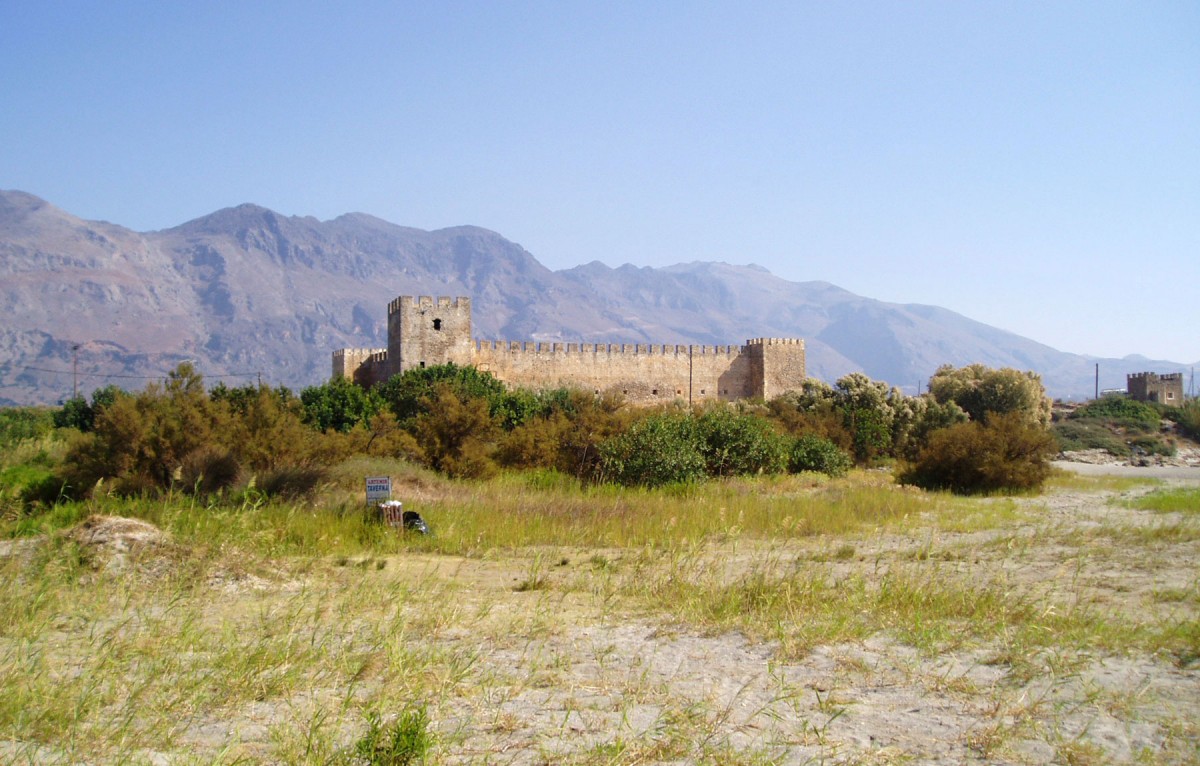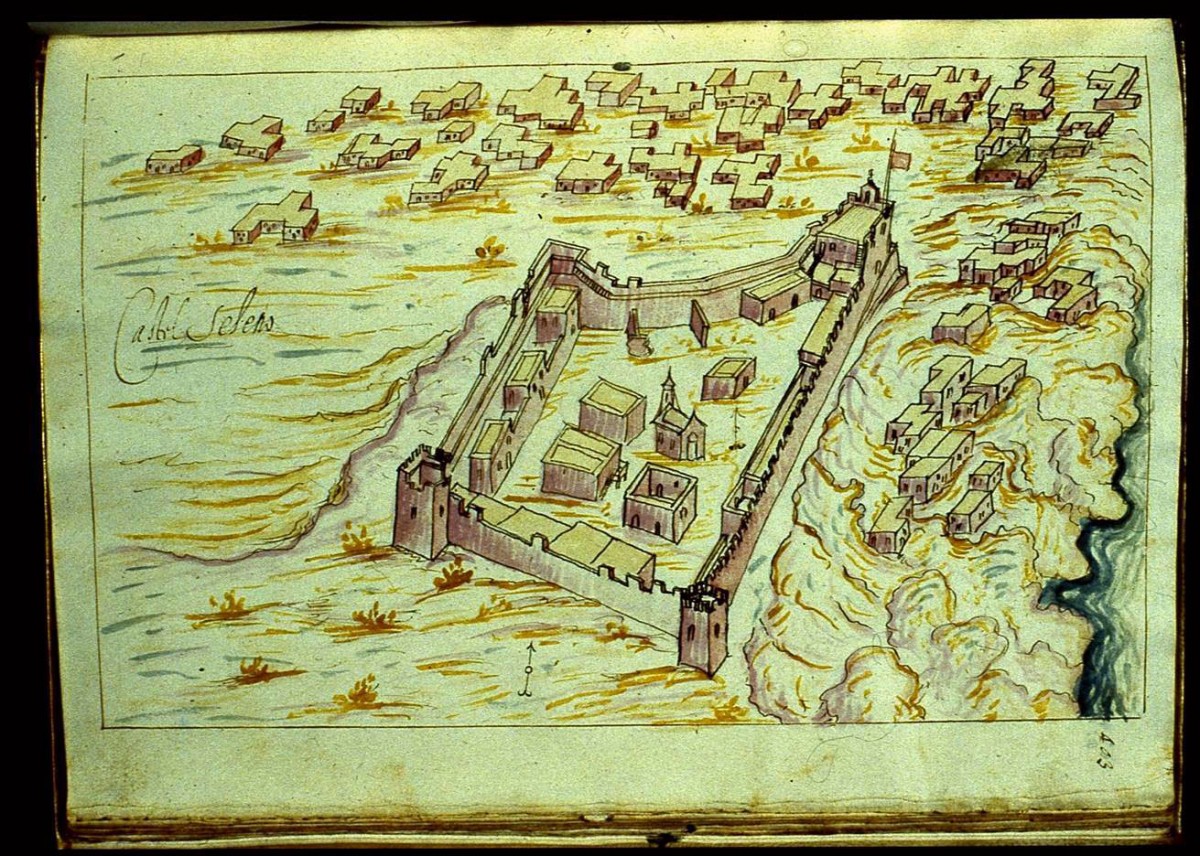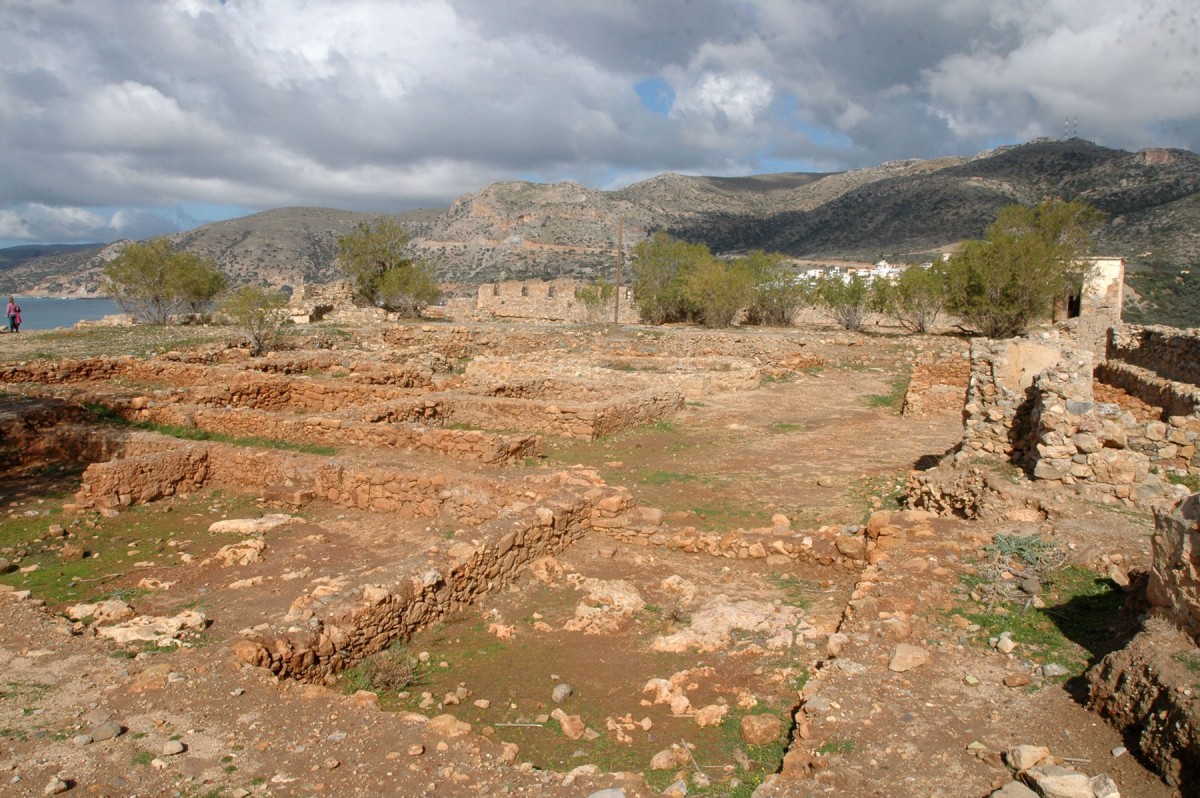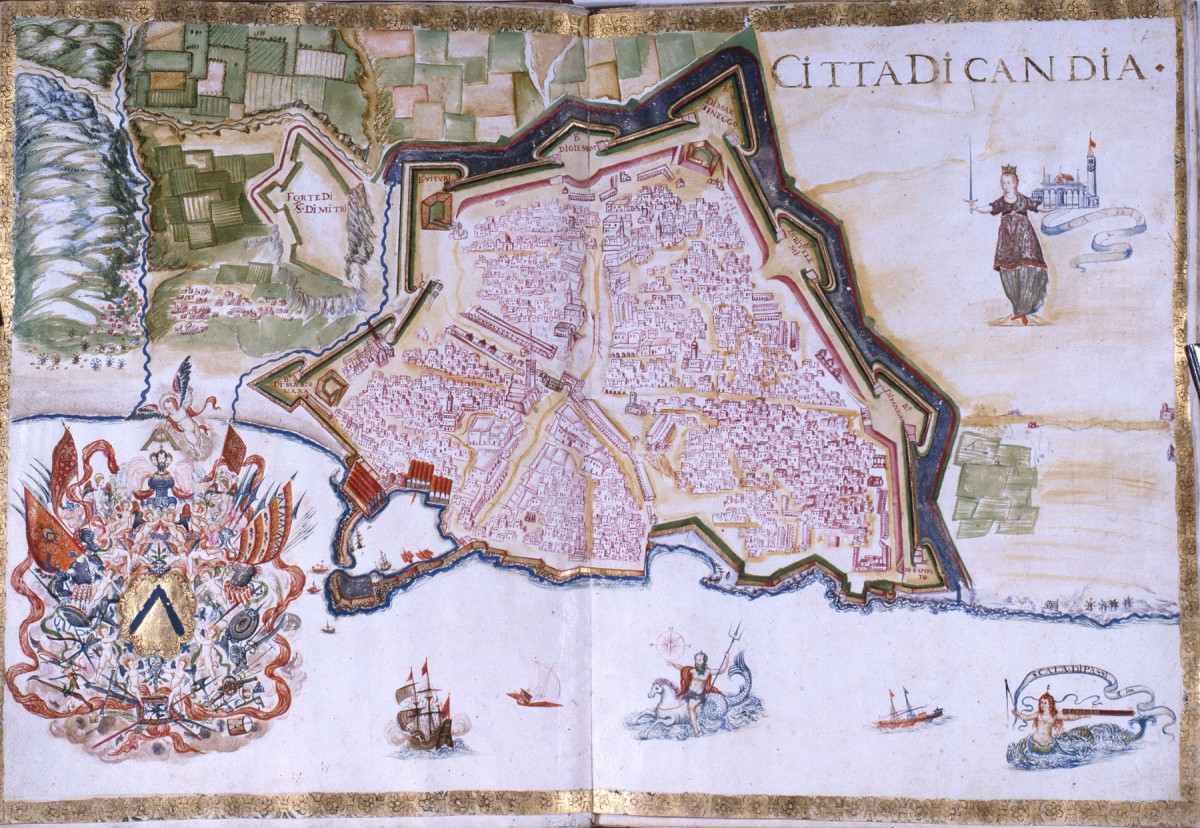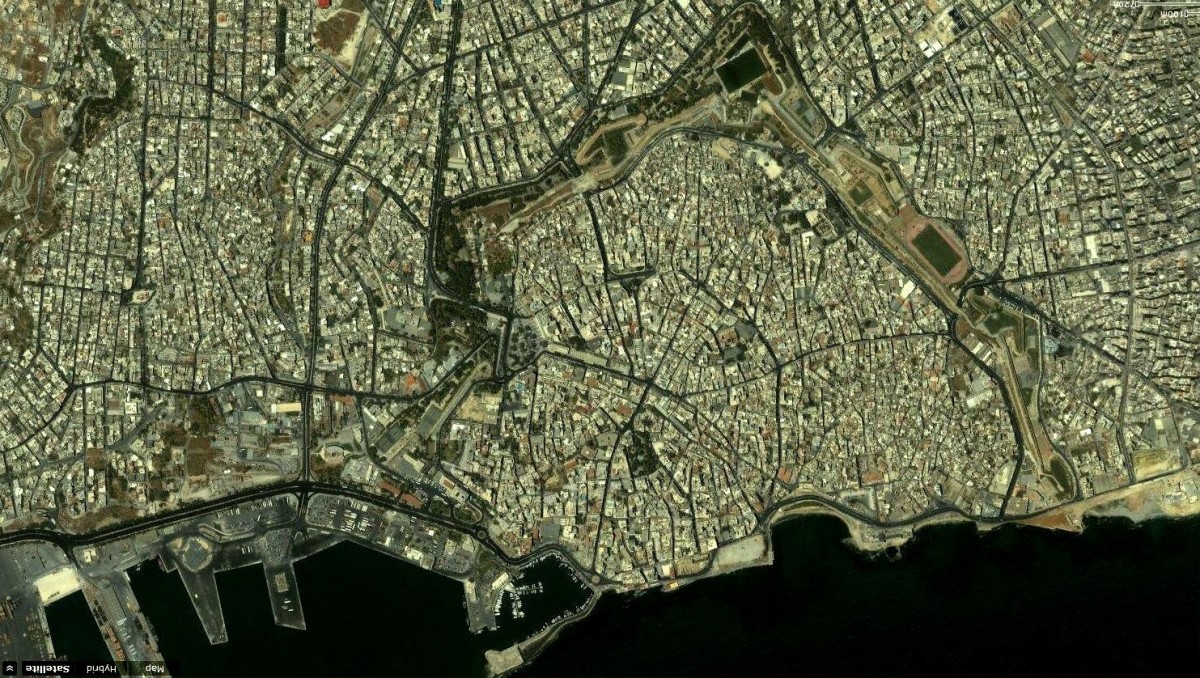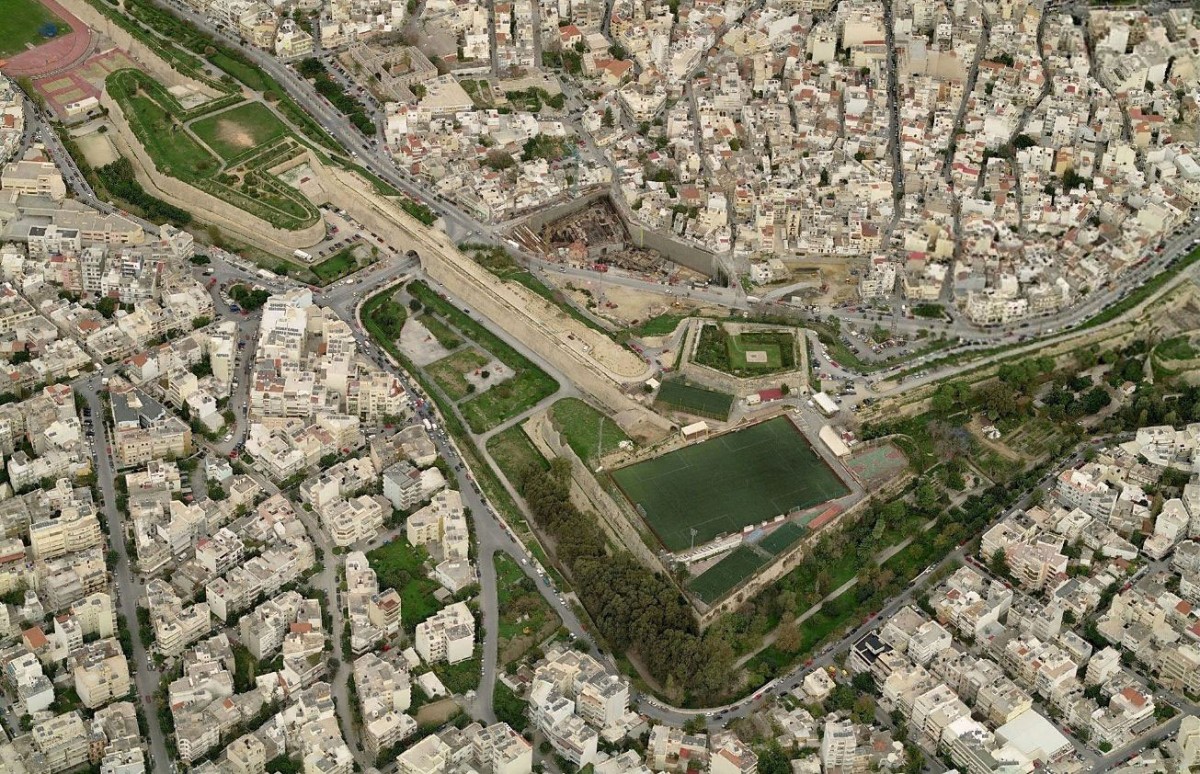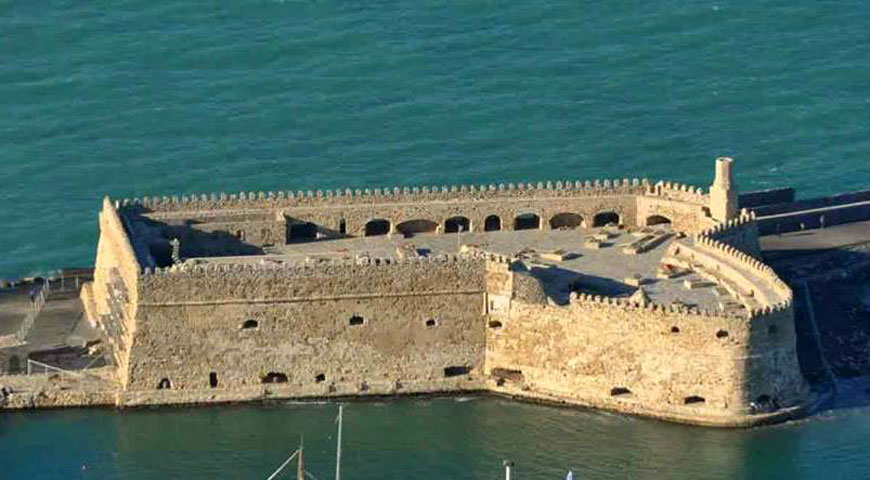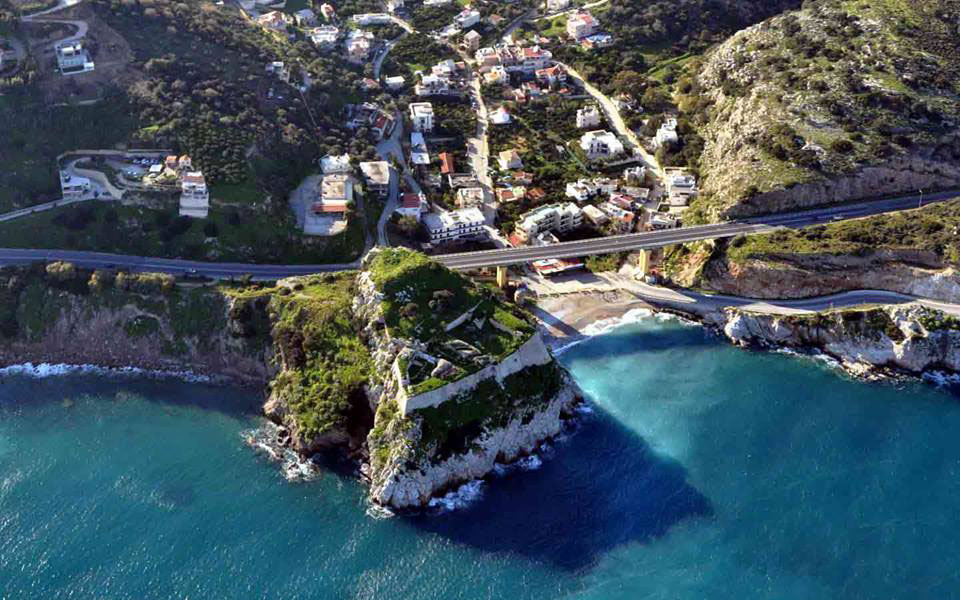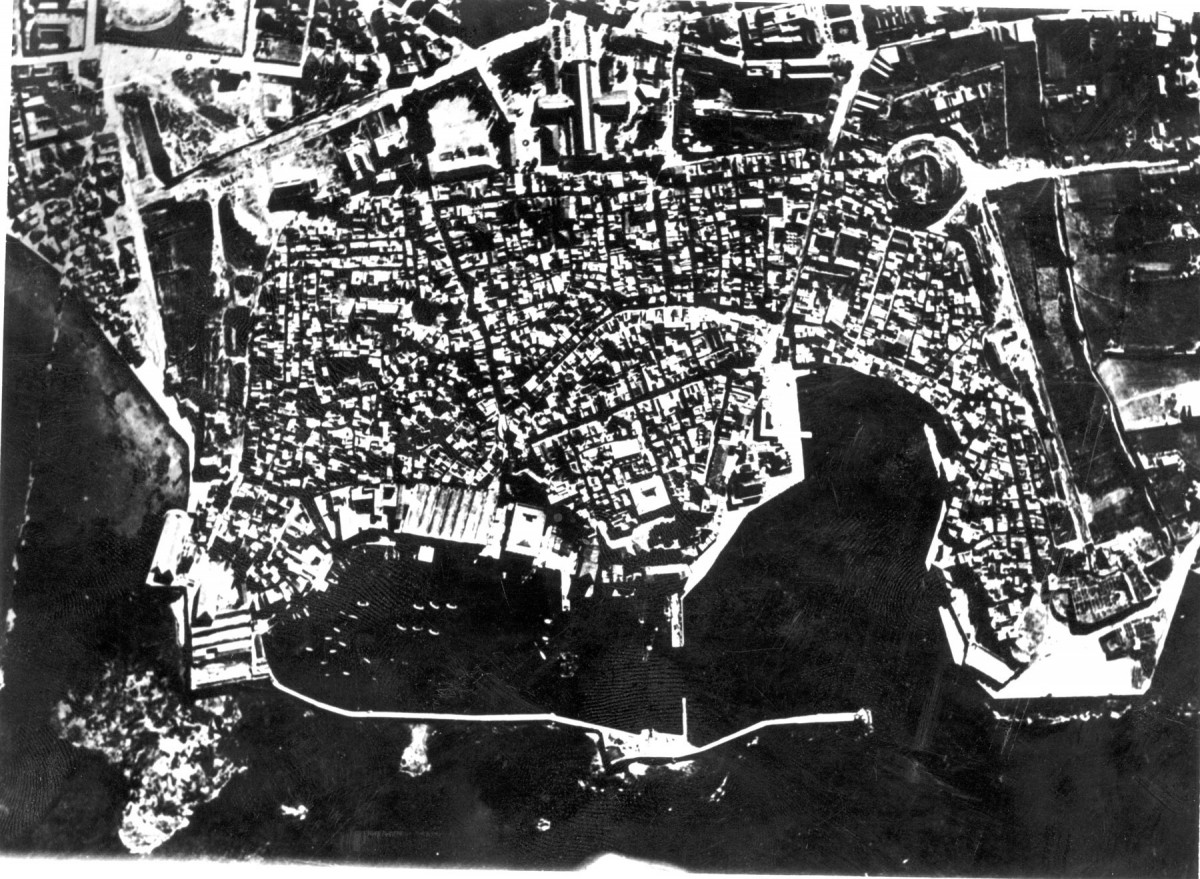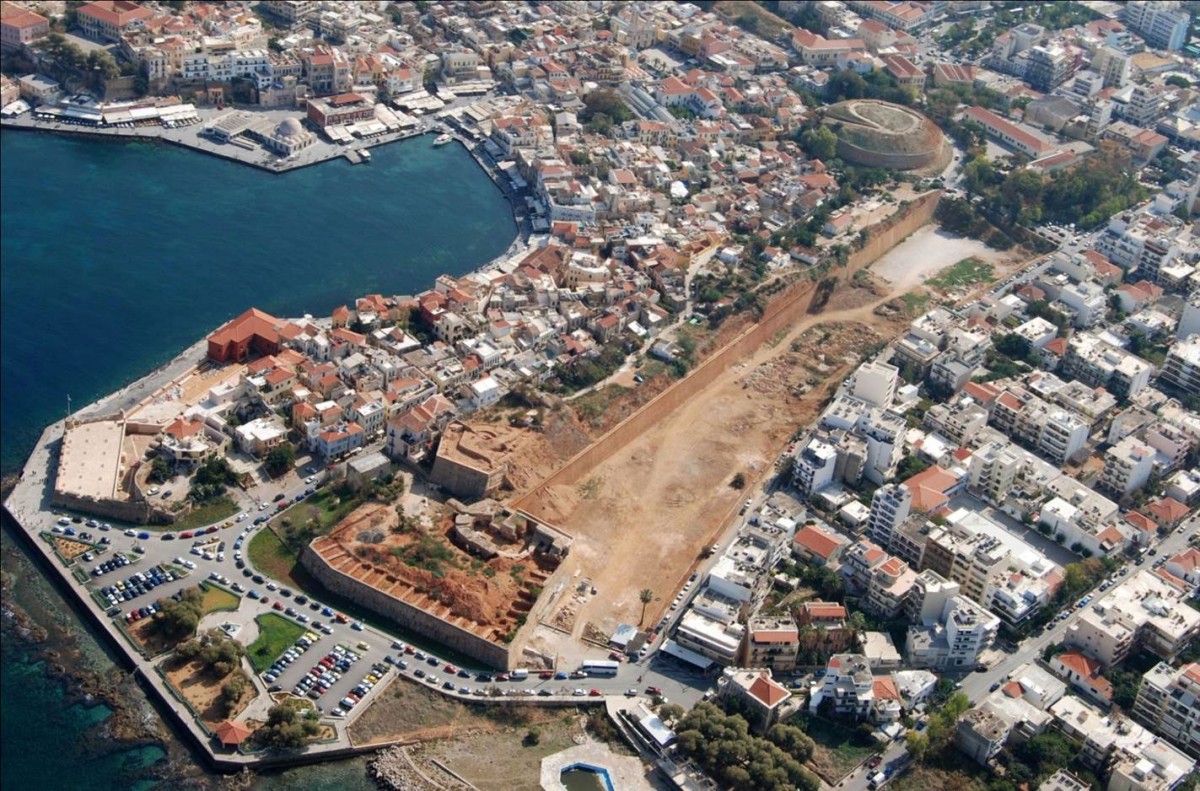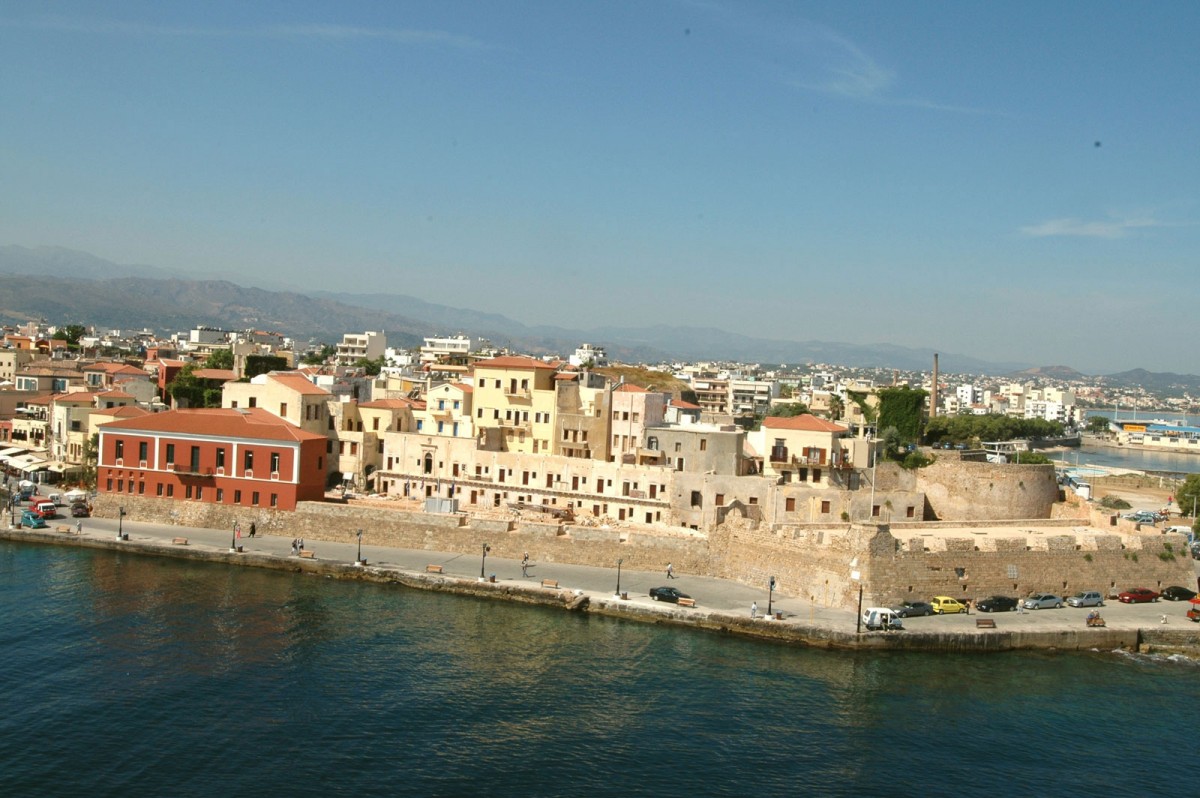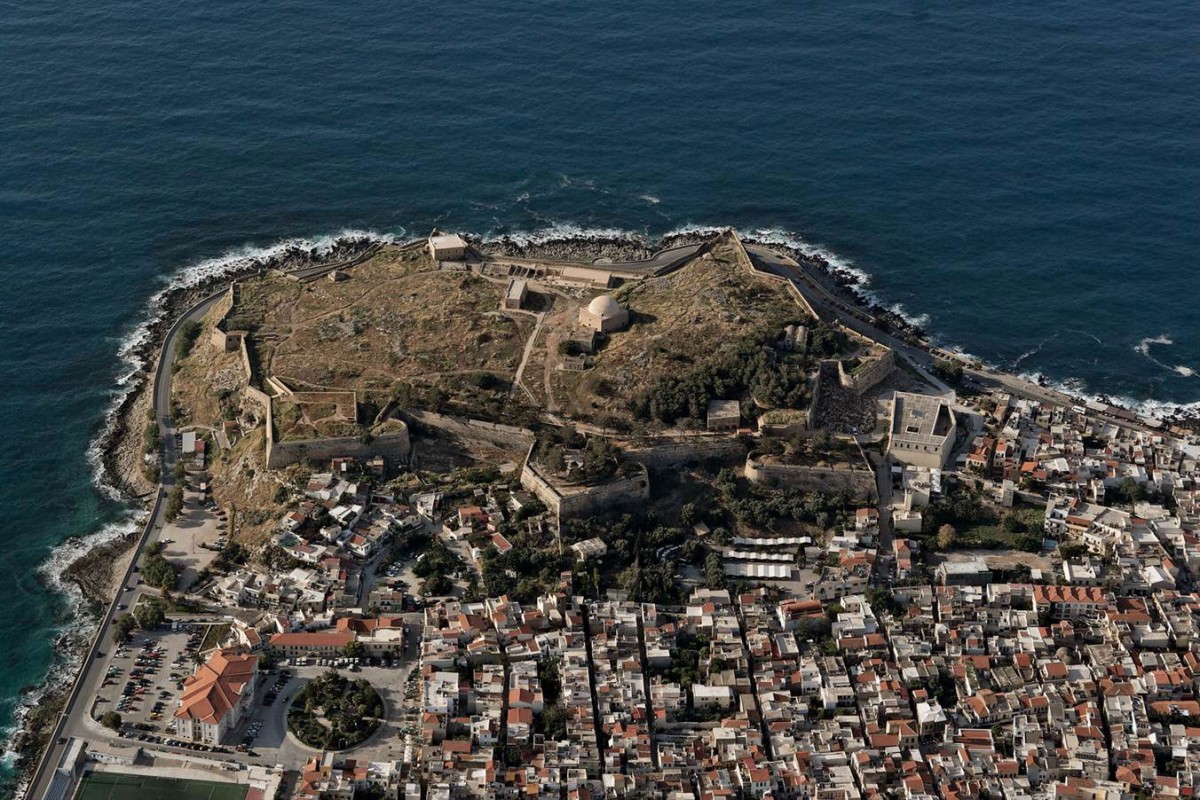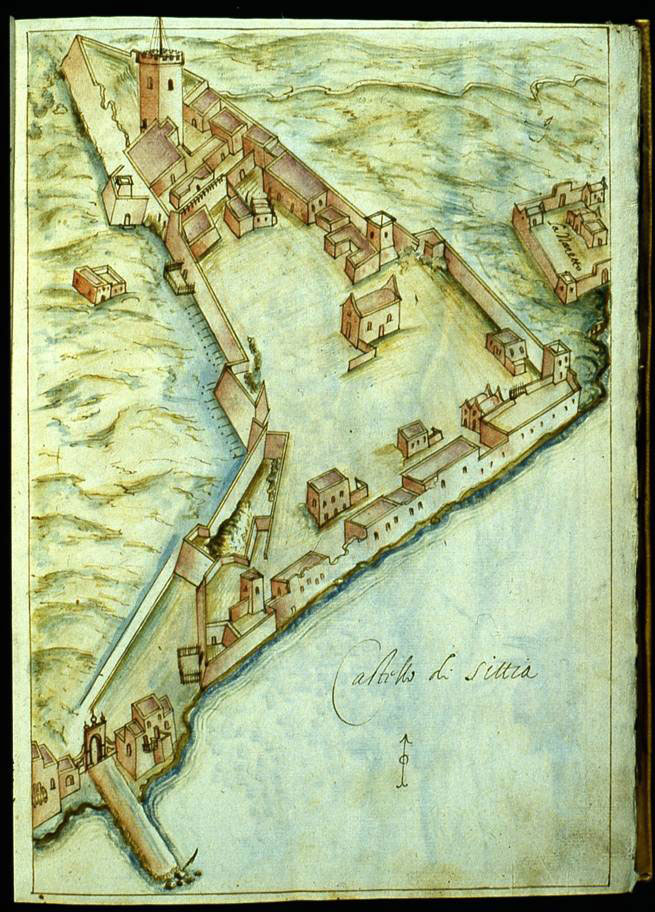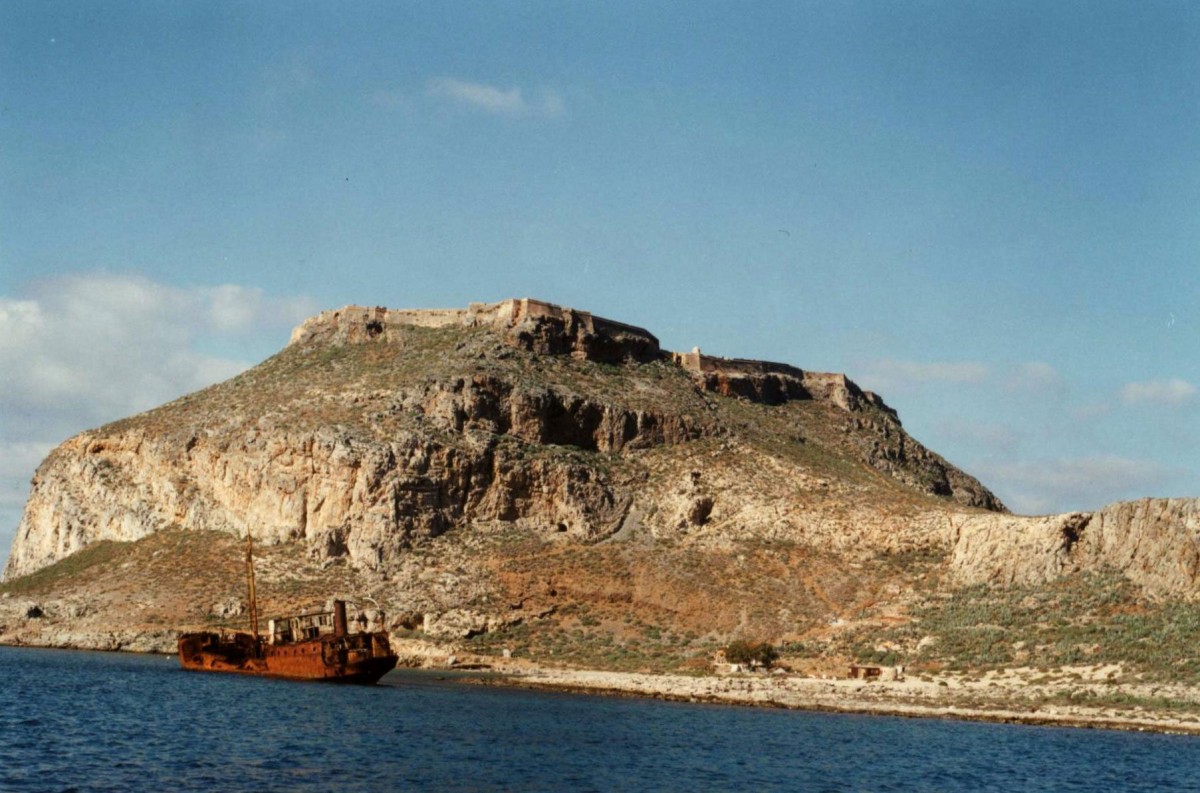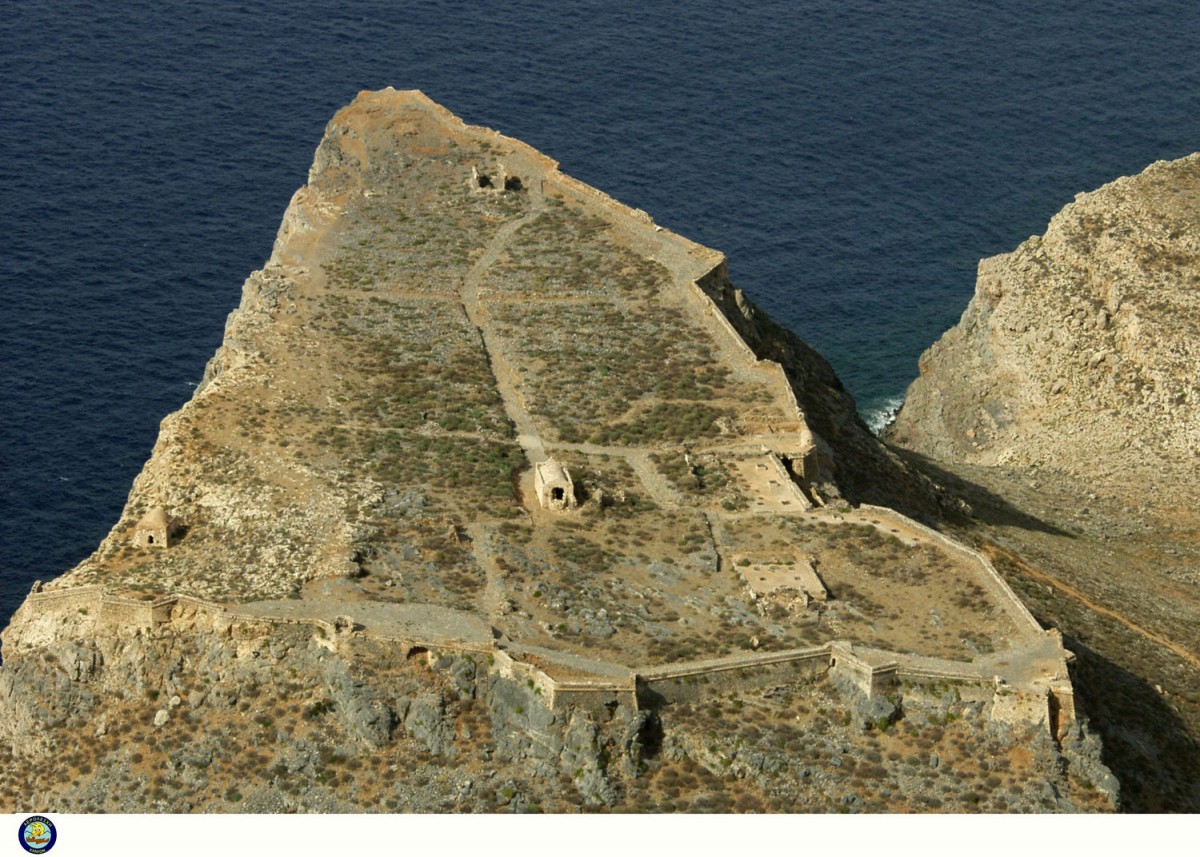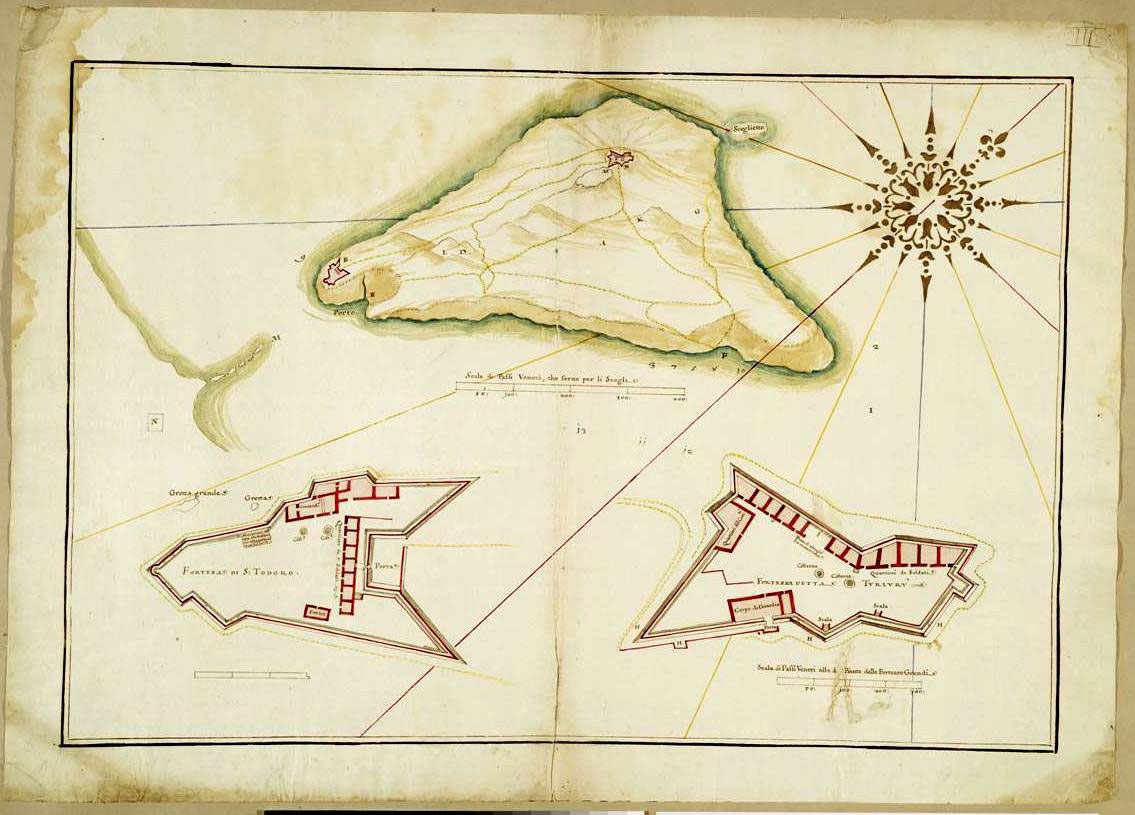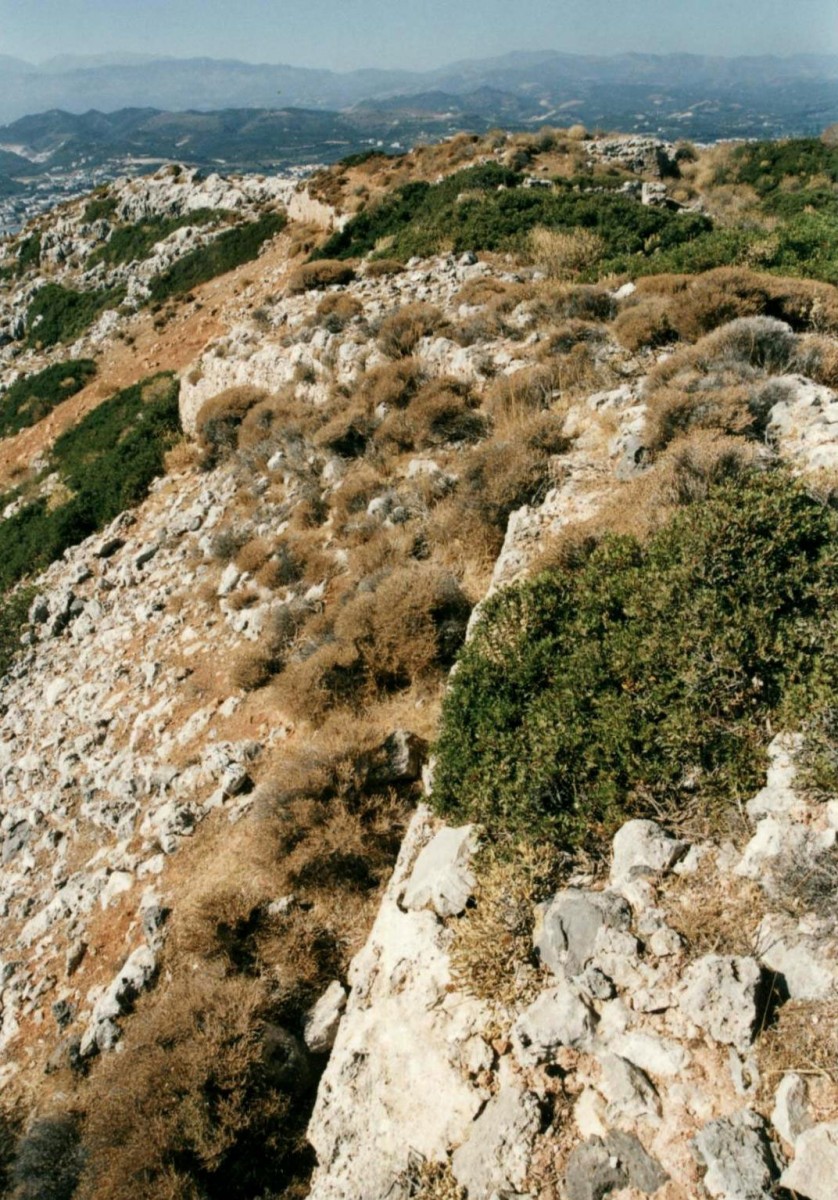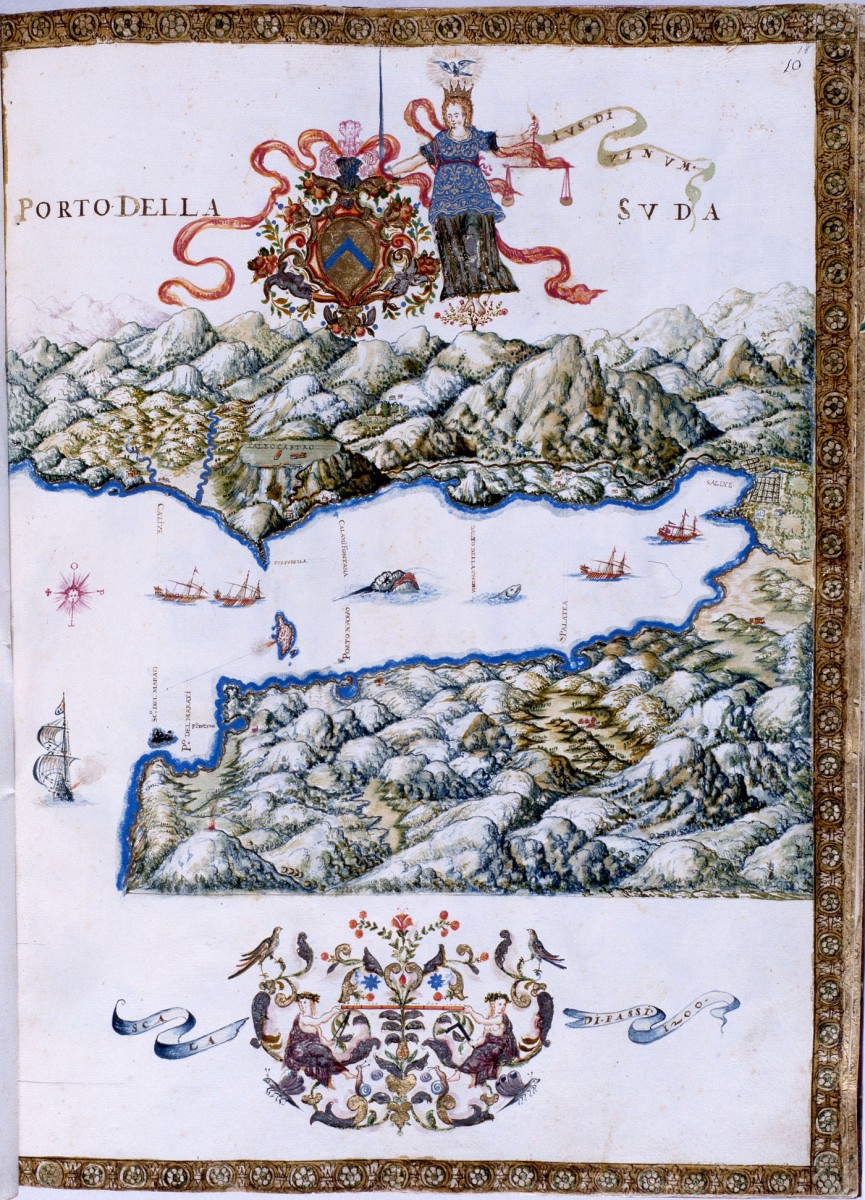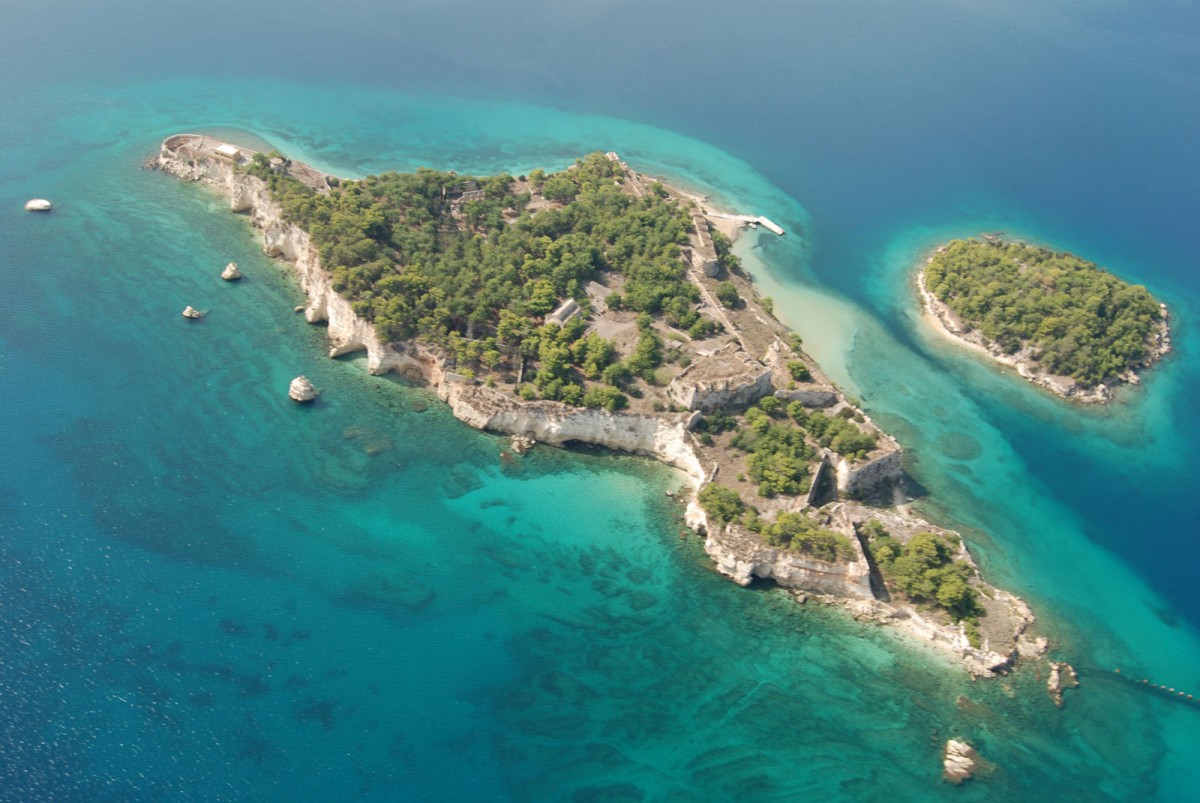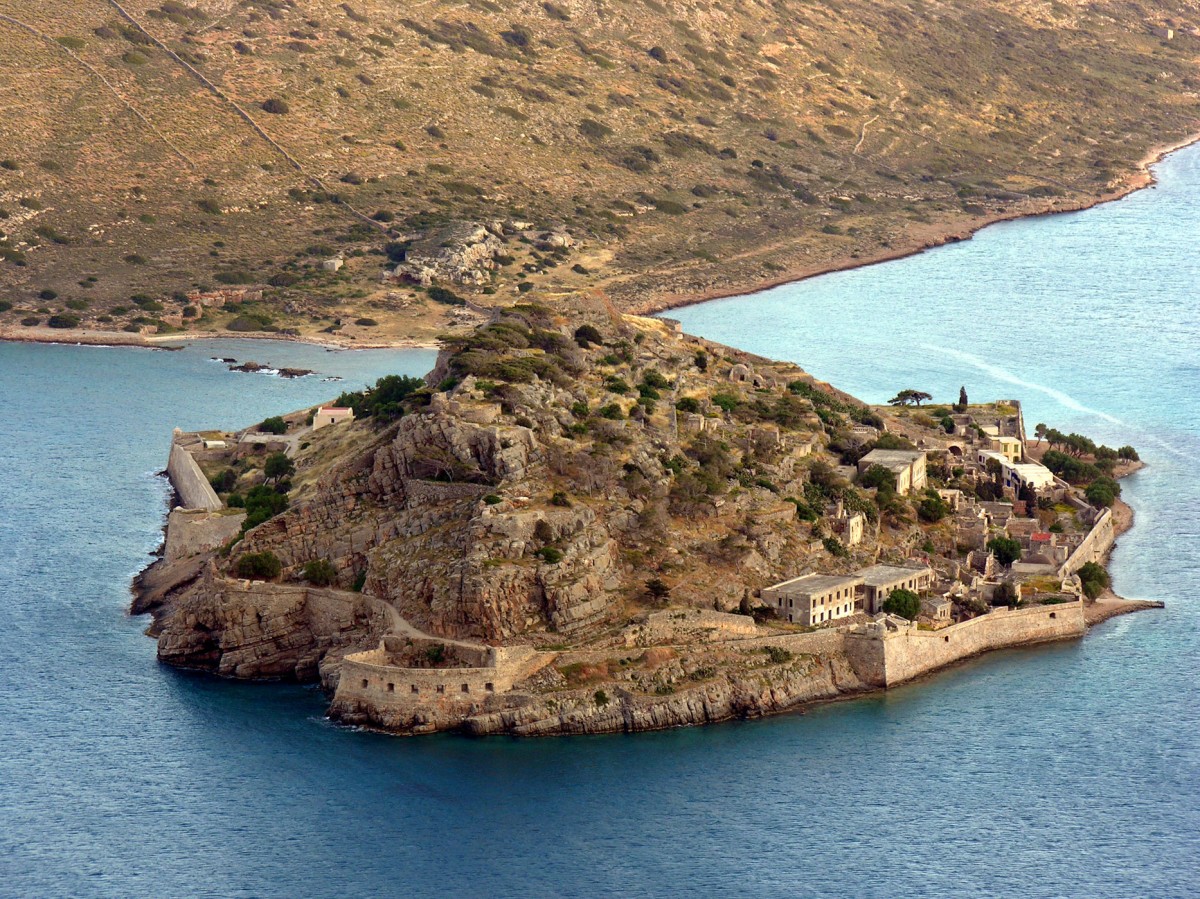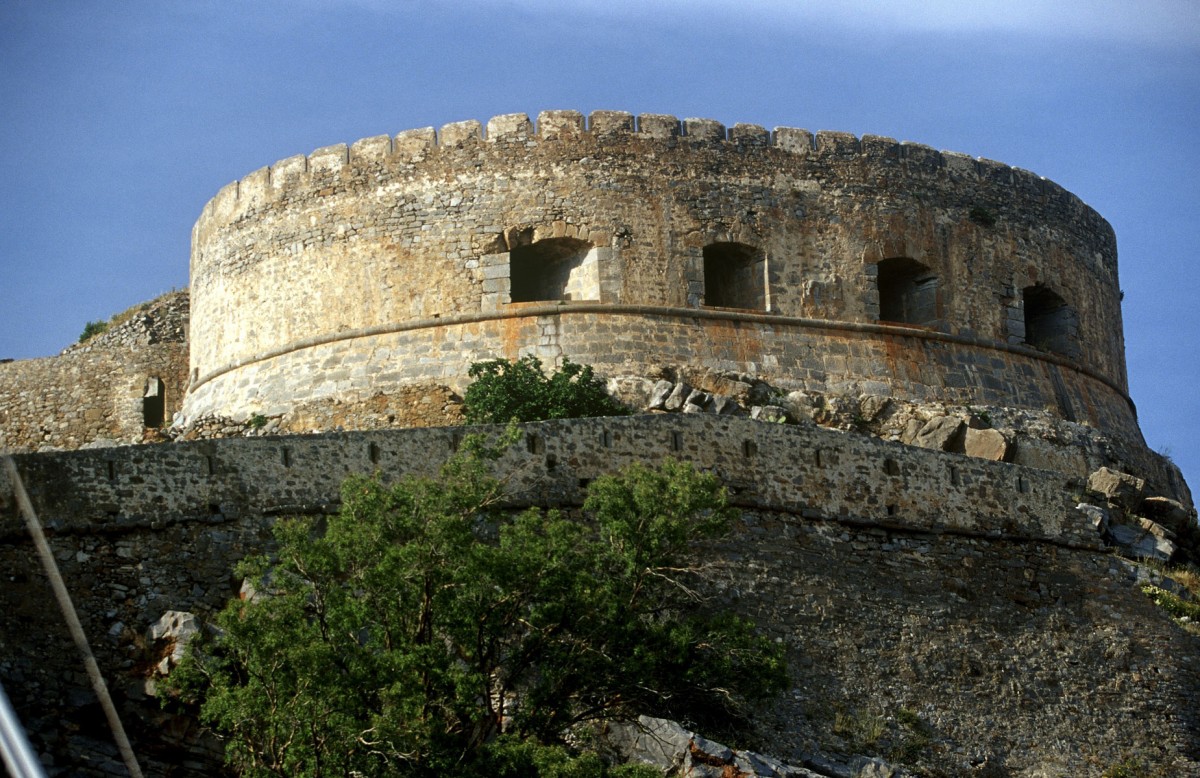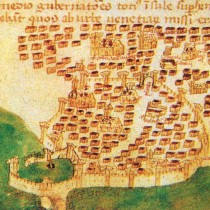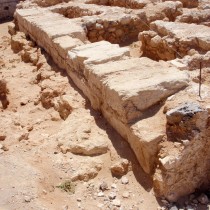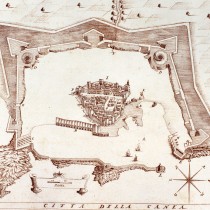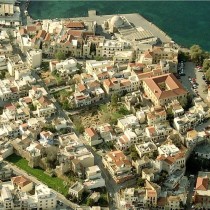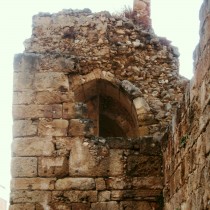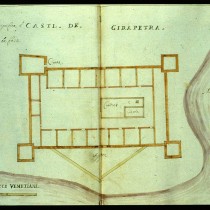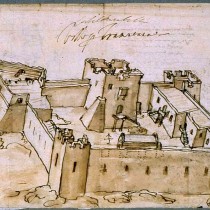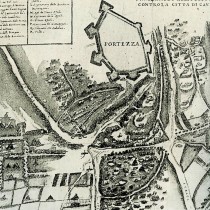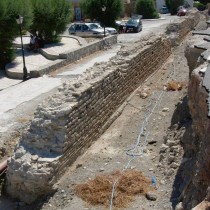Already prior to the Fourth Crusade and the sack of Constantinople by the Latins, Alexios, son of the deposed emperor Isaac II, had ceded Crete to Boniface Monferrat, head of the Crusaders. In the distribution of the Empire’s territories that followed, Boniface, in turn, ceded the island to the Republic of Venice, for the sum of 1,000 silver marks, so as to secure Crete’s support in his dispute with Baldwin of Flanders, the Latin emperor of Constantinople. Crete was of special interest to Venice, ruler of the seas, because of its strategic position in the centre of the Eastern Mediterranean, but also because it was an especially productive region that, as it turned out, constituted over many years its, Venice’s, main overseas territory. Over a period of time, Crete’s sovereignty was challenged by the Genoese pirate Enrico Pescatore who conquered Chandakas and also tried to establish his presence in the countryside. After 1206, Venice, having first faced other problems, sent a fleet to Crete and after a harsh confrontation, succeeded in getting rid of the Genovese and having signed an agreement, started, essentially after1211, to establish its rule in the new territory.
The next issue the Venetians had to face was the fierce resistance of the Cretans, who repeatedly organized revolutionary movements led by powerful, local feudal lords, supported by the Byzantine Empire exiled in Nice and guided by the Orthodox Church. These revolutions usually ended in treaties between the Cretans and Venice. The conquest of Crete was completed in 1252 with the “re-establishment” of the city of Chania and settlers being established there. The Cretans continued to react strongly during the 14th century as well. The fall of Constantinople in 1453 and the certainty of Crete’s imminent conquest by the Turks now shattered all hopes of the nation being restored. As a consequence, the two peoples coexisting on the island, came together and collaborated in the face of a common enemy. Despite the serious efforts made over almost a century to strengthen defences, Crete’s conquest by the Turks gathered speed after 1645 when Chania was taken, until the fall of Candia in 1669, after a long, harsh siege. The strong defence system in Crete developed during Venetian rule within this historical framework and along with more general developments in the field of fortifications.
In the early 13th century, having started already in the second Byzantine period (961-1204), there was a well developed defense network that included Chandakas, the only urban centre, the small settlements and the harbours of Rethymnon, Cydonia (Chania)and Sitia, as well as key points inland and basic communication routes. Several of these forts were utilized by Pescatore who, according to sources, built or repaired 14 forts over a very short period. Given, however, that Pescatore had very limited time and resources, also that information is rather vague and archaeological research not advanced enough, it is thought most likely that he used existing forts, having first repaired them. Several of these forts were used by local revolutionaries in their fight against the Venetians over the next period.
When the Venetians settled in Crete, apart from organizing administration on the lines of the Metropolis, they saw to rebuilding and strengthening the fortifications of their capital of Candia (Chandakas). They found the fortification enclosure in a bad state. This had initially been constructed in the Proto-Byzantine period, on the site and with materials from the pre existing ancient walls. Then it had been repaired and greatly expanded by the Saracens, suffered considerable damages after the siege by Nikeforos Phokas, to be subsequently repaired one more time by the Byzantines. The enclosure completed the natural fortification of a coastal hill and protected the settlement and its natural harbour to the north. It follows the terrain’s morphology, with the hill to the east and slopes gently to the west, reaching today’s Chandakas street, where it turns south. It is made up of straight curtain walls alternating with rectangular towers, on the lines of medieval fortifications, so as to face the offensive weapons of the period with their relatively limited effects. From very early on, whole quarters, the exoburgoi, developed outside the walls, mainly to the south of the town. Recent archaeological surveys have clarified several issues regarding the fortified settlements’ western boundaries which extend further than that believed in the past. It also appears that quite a large part of the Proto-Byzantine walls are preserved, which were then used for supporting the subsequent building phases. The city developed within the fortification enclosure, which is divided in two, from south to north, by the main road (Ruga Magistra), that leads from the entrance gate to the harbour. It had public buildings, a great number of catholic and orthodox churches as well as residences of the ruling class and citizens. Similar actions were taken in the settlement of Rethymnon, where, surrounding the small harbour, the trapezoid shaped Byzantine walls survived, referred to in the sources as the Castel Vecchio or Antico Castello. With the establishment of the new administration and Crete’s final division into four geographical departments (territori) during the 14th century, Rethymnon, Chania and Sitia evolved into fortified urban centres.
Chania, however, is the city that gives us most information about the appearance and early fortification of Crete’s urban centres. This is because it has remained almost intact, the sources provide us with quite clear information and the ongoing work of research and restoration allow one to form a more complete picture.
The ellipsoid shaped ancient fortification enclosure was reconstructed in the 7th century, with building material from the previous one and from city buildings ruined by earthquakes, in order to protect the citadel from Arab raids. After the 1252 mandate to “re-establish” the city, the settlers see to the repair and extension of the fortification that was in a poor state. One recognizes the Venetians’ interventions in the following: extensive reconstruction of the inner side of the walls – less thick than they were originally – the modification of the towers’ interiors with pointed arches, the construction of the gates as well as small changes in the walls’ course. For this purpose, apart from stone blocks, available on the site, smaller blocks of sandstone and strong mortar are used on the outer surfaces. The gaps left between the outer facades are filled with solid cast masonry, as in the Proto-Byzantine phase. Strengthening the fortifications of Sitia was an issue tackled quite early on and the fort of Ierapetra was constructed in Crete’s most eastern region.
The Venetians took the above measures so as to establish both their presence and their security on this island which was inhospitable to them, especially in urban centres where they were predominant and the authorities had their headquarters. They also secured safe port facilities in suitable spots, for the trafficking of merchant and war ships. The Venetians saw to the founding of smaller forts or fortified settlements, called castellanie or castelli, in the seats of the provinces of the four geographical departments or territoria. This was done to protect the feudal lords, control a particularly restless hinterland where the Greeks greatly outnumbered the Venetians and to practice decentralized administration. In the Chania district, apart from the city itself, there were four more castelli; the Castel Apicorno, the Castel Chissamo, the Castel Selino and the Castel Sfakia. Moreover, to the east of Sfakia was the Castel Franco with no administrative responsibilities but there to control the insubordinate locals. The castelli of Selino, Sfakia and the Castelo Franco were simple forts, whereas those of Apokoronas and Kissamos were fortified settlements. In the district of Rethymnon, outside the city were the castellanie of Milopotamo, Apano Sivrito in the area of Amario and Kato Sivrito in the area of Aghios Vassilios, of which a handful of ruins survive. Respectively, in the region of Heraklion, the ruins of forts survive in the seats of the following castelli; CastelTemene, Castel Belvedere, Castel Bonifacio, Castel Priotissa, Castel Nuovo, Castel Pediada and Castel Malvesin. Last, in the Lasithi region, apart from Sitia, there were the Castel Mirabello and Castel Gerapetra. It also seems, that in the era of Venetian rule, some role was played by a series of pre existing forts in the Cretan country side.
To organize the primarily administrative role played by these facilities, either the existing infrastructure of the Byzantine fortification network was utilized by repairing and expanding it, or new fortifications were built. For the most part, the Venetians’ administrative division of Crete was identical with the Byzantine turmes, but also with the later Ottoman provinces (Nahiye) or the provinces of the Greek state. Both the appearance of the forts and the manner of their construction, continue the hitherto practice of alternating rectangular towers with curtain walls, while the masonry is now rubble and strong mortar. When the terrain is flat, the forts are rectangular with towers in the corners like the Castelo Franco, the Cale fort in Ierapetra, the forts in Pediada, in Mirabello also with adaptations of the area’s shape on its north east side, the Castel Selino in Palaiochora. In other cases, at key locations that secure the supply of water, naturally fortified hills are utilized and are further reinforced with strong walls surrounding settlements. Inside the forts are buildings necessary for providing administrative and military services, store rooms, reservoirs, churches of both creeds, when possible, as well as private homes. The simple upkeep and defense of the forts are responsibilities of the feudal lords of the area, who primarily, take full advantage of their existence. More serious operations call for the official approval and intervention of the central administration. The ongoing excavations at Castel Selino offer a fair amount of information on the manner of this group of forts’ organization, operation, occasional interventions and equipment.
The poor state of the fortification works caused by revolutions, earthquakes, or lack of maintenance is a frequent phenomenon, as seen in reports by authorized functionaries and engineers and also by research on the monuments themselves. As the 15th century advances and especially after the sack of Constantinople, important changes can be observed that influence both the state of affairs in general and the relative calm now established on Crete. The decline of feudalism combined with the rapid growth of urban centres, the easing of differences between Cretans and Venetians, the Ottoman Empire’s expansionist tendencies as well as the development of gunpowder and fire arms, oblige Venice to resort to new plans regarding the preservation of its overseas territories. Initially, at the end of the 15th century, there is an attempt to strengthen the old fortifications in Candia by expanding on the outside with strong, slanting masonry, such as found on the south side, so as to successfully confront the constantly evolving firearms. At the same time, the request by the population of Candia had already been granted since 1462 for the construction of a new, wider fortification enclosure, to protect the settlements rapidly developing outside the original one. This work, however, progresses very slowly. In Chania, on the other hand, as of the 14th century, a second, wider fortification enclosure has been constructed which is successful, while similar attempts at improving the existing situation are also constantly being made in several other forts on the island. As time goes by, however, itbecomes clear that limited interventions would not be able to tackle the imminent threat of a Turkish attack.
The anticipated campaign to capture Venice’s territories in the Mediterranean, now demands the planning of a new, outward looking defence network, to protect the cities and key coastal points from sea attacks. In 1501, a three member committee of experts in fortification works was sent to Candia to examine the options. Thus began the construction of new fortifications, yet again without any real planning, with sporadic work done in several spots. The need to seriously confront this issue was accelerated by the third Venetian Turkish war (1537-1540). In 1538, Venice was forced to send to Crete an expert in fortification works, the great Veronese architectMastro MicheleSanmicheli, who undertook the construction of the Candia fortifications as well as those of Chania and Rethymnon. Sanmicheli was one of the main theoreticians in the developing Bastion System (Fronte Bastionato) like other engineers after him. Thus Crete’s fortifications, especially those of Candia, one of the biggest works in Europe to be constructed in those crucial times, constitute important examples of evolution in the field of fortification, that will prevail till the 19th century. The city’s subsequent long siege, highlighting the system’s positive and negative aspects, also contributed to the developments.
Sanmicheli asked that the old fortifications of Candia be demolished ‒ although, this did not happen ‒ and designed new ones, taking into account the terrain, a factor which determined the fortifications’ shape. In the design he included sections, whose construction he had already advanced along with all the settlements outside the old walls, and several available pieces of land for growing crops to sustain the city, especially when under siege. The extensive fortification enclosure was surrounded by a wide, dry moat, whose crops also sustained the city in times of peace. Despite it being a matter of urgency, the fortification works in Crete progressed slowly, mainly for financial reasons. Venice’s gradual loss of territories, however, forced it to take serious action. The capable engineer Giulio Savorgnano played a decisive role, when he was made responsible for the project in 1562 and who saw to the modification and completion of the initial design, as well as the speeding up of the works. Bastions are added on the outside of the main enclosure, such as that of Aghios Demetrios to the east, improving its effectiveness, while constant modifications are decided on and realized, even during the long siege. The harbour’s protection was reinforced by reconstructing the very strong Rocca al Mare fort on the site of an earlier one. Candia’s defence was also reinforced by other works in the greater area, such as the Palaiocastro fort, on a steep rock by the sea, to the west of the city. The fort’s objective was to stop both the approach of the enemy fleet and the supply of water from the large Armyros beach, suitable for landing.
The new fortifications in Chania, the second city in “the Kingdom of Crete”, were designed by Michele Sanmicheli and built with the supervision of other important engineers, such as the nephew of Gian Girolamo Sanmicheli. The two earlier fortification enclosures had long since been outgrown and the settlement’s expansion outside the walls, combined with the terrain, now required the former’s effective protection. Already in 1502, there is evidence of trenches being opened for the construction of a new enclosure without any design, and with expenses equally divided between the government and the population. The construction of new fortifications began in 1538 and advanced at a relatively quick pace, with the population contributing in both labour and finances. Officials serving in Crete also took part in supervising the works. Durable sandstone was utilized from the coast of Stavros in Akrotiri and to the west of the city and the stones arrived by sea. It is very possible that building material was also used from the earlier 14th century enclosure, traces of which have not been located. The shape of the new fortifications was rectangular, with the long north side forming the port’s breakwater. Bastions were constructed on the four corners as well as a big piattaforma in the middle of the long south side, on which today’s Municipal Market is built. The effectiveness of the bastions was strengthened by ramparts placed higher up. The powerful RivellinodelPorto was built on the west side of the harbour’s entrance, with cannon openings on two levels. Here, during this work’s construction as well, changes and improvements were made, some of which materialized, while others remained as plans. The city of Candia’s defense was further strengthened by fortifications on the islet of Aghioi Theodoroi, aka Theodorou, two forts on the west coast intended to stop a fleet from landing and, to the east, the complete fortification of the Aghios Nicholaos islet and other key spots at the entrance of the strategically important Bay of Souda.
Similar action was also taken to protect the city of Rethymnon, where once more the initial design was made by Michele Sanmicheli. Here, likewise, the small Castel Vecchio surrounding the harbor had been outgrown and the city had expanded to the south. The city’s location on a small peninsular protruding from the linear terrain of the exposed beach of Platanias, led to the designing of straight walls with three bastions and a moat which ,in effect, cut it, Rethymnon, off from the hinterland. The effectiveness, however, of this new fortification was limited, because of the hills that were at a small distance from the south side. For this reason and after the city’s destruction in 1571 by the raid of Ulutz Ali , a new plan of defense was thought necessary , with the fortification of the Palaiokastro hill, by the sea to the north of the city , to be used as a refuge by the population in case of a new raid. The star shaped Fortezza was built rapidly, on the hill top, to the original plans of SforzaPallavicini, but the city’s population refused to move there. The city of Sitia was similarly reinforced by the construction of triangular, perimeter walls, starting from the Cazarma fort on a hill top and ending on the seafront.
Along with the new fortifications in urban centres and the repairs and updating of the most important inland castelli, the Venetians took great care to strengthen the defense of key points on the northern shores, especially after the mid 16th century. They aimed to stop the enemy fleet from approaching harbours or beaches suitable for landing and from where it was easy to reach urban centres, as well as stopping the access to water supplies from coastal springs. Thus forts and “look out posts (vigles)” were designed and some constructed on many coasts and islands. To the west of Crete, on the inaccessible rock summit of the Himeri Gramvousa islet, a fort was built to stop a fleet from approaching the small, natural harbor on the opposite peninsular by the same name. In 1579, on the other end of Crete, strong fortifications on the Spinalonga islet began to be constructed to the original designs of the engineer Genese Bressani with important modifications by the engineer LatinoOrsini, so as to control the entrance to the very wide Elounda Bay. Similar fortifications covered the whole of the islet of Aghios Nicholaos, at the entrance of the strategically very important Bay of Souda, to stop the enemy fleet from landing, near the city of Chania to the east. Respectively, from the west side, in the middle of the Chania Bay, on the Aghioi Theodoroi (Thodorou) islet, two forts were built on a hilltop and opposite the coast of Aghia Marina which was suitable for landing. The hill top fort sought to control a greater sea area and protect the city, while the fort to the south wished to control a fleet from either landing or accessing water.
The conquest of Crete by the Turks that started in the summer of 1645 with a surprise attack on the city of Chania, found the fortification works in an advanced stage, without, however, such readiness on the part of the Venetians and the locals. The fort of the Thodorou islet was blown up by Biagio Julian, head of the garrison, sending both friends and enemies to their deaths. After a brief, taxing siege, the city gave itself up to the Turks and became the starting point for the island’s conquest. Factors contributing to the sack of the city were the surprise attack, the Venetians’ inability to provide reinforcement in the face of large numbers of a well organized army, as well as imperfections and flaws in the design of the fortifications. The Turks’ advance on eastern Crete was relatively easy and in a short time both the Castel Apicorno fort and the city of Rethymnon fell, in 1646, giving the Venetians time to prepare the defense of Candia. Nevertheless, the long, harsh siege and the city’s final surrender in 1669, following treason, highlighted the value of its fortifications, combined with the heroic resistance both by Venetians and Cretans, who were not sufficiently helped in such a struggle by other Christian forces in Europe. This siege shed light on the positive and negative elements of the bastion system and seriously contributed to its evolution in Europe, in the years to come. After the Treaty of Candia’s surrender, Souda Gramvousa and Spinalonga were now the only fortified islets remaining in Venetian hands, to be used as a base for their activities in the Mediterranean and their failed attempts to retrieve Crete, with the help of the local population who sought refuge in these forts.
Finally the fort of Gramvousa surrendered to the Turks, following treason, in 1691. The forts of Souda and Spinalonga withstood enemy pressure under very difficult conditions and surrendered in 1715. With this act, a long period for Crete, during which much of importance happened, finally comes to a close. Thus the long period of Venetian occupation in Crete finally ended after a long war, which largely vindicated the marked efforts made to strengthen the island’s defense and also highlighted the potential as well as the weaknesses of the evolving bastion system.
Michalis G. Andrianakis
Honorary Curator of Antiquities
